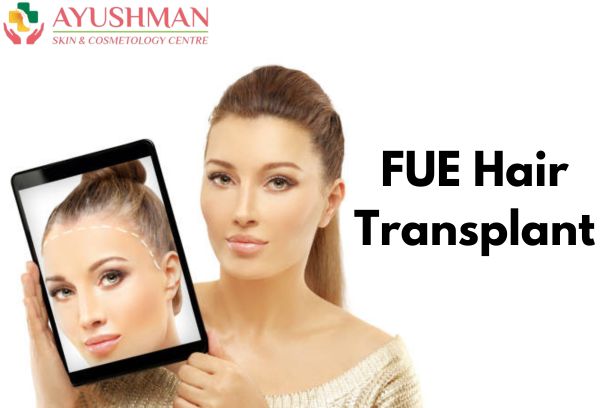Table of Contents
ToggleFUE Hair Transplant
FUE, or Follicular Unit Extraction, is a minimally invasive hair transplant procedure that addresses hair loss. It involves extracting individual hair follicles from a donor area on the scalp, typically the back and sides, and transplanting them to a thinning or balding area. This approach creates a natural-looking, thicker head of hair.
FUE hair transplant has emerged as a popular alternative to the older technique called Follicular Unit Transplantation (FUT). Unlike FUT, which removes a strip of scalp leaving a linear scar, FUE treatment uses tiny punches to extract individual follicles, resulting in minimal scarring. This minimizes the risk of the unnatural “hair plug” appearance sometimes associated with FUT.
This procedure is well-suited for individuals with thinning hair or bald spots who still have a healthy area on their scalp to serve as the hair follicle donor site. However, those with limited healthy donor hair may not be good candidates.
FUE Hair Transplant Process
FUE treatment for hair transplants addresses hair loss by meticulously transplanting healthy hair follicles to bald or thinning areas. Here’s a breakdown of the process:
- Donor Area Selection: A suitable area on the scalp, typically the back and sides with strong hair growth, is chosen to provide the hair follicles.
- Follicle Extraction: Using a tiny punch tool, individual follicular units (containing 1-4 hairs) are carefully extracted from the donor area. This minimally invasive approach minimizes scarring.
- Follicle Preparation: The extracted follicles are meticulously prepared and kept cool to ensure their viability for transplantation.
- Recipient Area Preparation: Tiny recipient sites are created in the bald or thinning area where the new hair follicles will be implanted.
- Follicle Implantation: Each follicular unit is meticulously placed into the recipient sites, ensuring natural-looking hair growth direction and density.
- Recovery: Following the procedure, the scalp heals and the transplanted follicles begin to grow hair, typically within a few months.
FUE Hair Transplants: Potential Side Effects and Risks
While FUE hair transplants are generally safe, it’s important to be aware of potential side effects and risks:
- Minor scarring: Unlike older techniques, FUE treatment leaves minimal scarring. However, tiny white dots may appear at the donor sites where follicles were extracted. These typically fade over time.
- Infection: As with any surgery, there’s a slight risk of infection. Be alert for symptoms like drainage, redness, or increased pain at the surgical site.
- Pain and swelling: Mild pain, swelling, and discomfort are common after the procedure and can be managed with medication.
- Folliculitis: This is an inflammation of the hair follicles, causing small red bumps. It’s usually treatable with antibiotics.
- Bleeding: Some minimal bleeding is possible during and immediately after the procedure.
- Numbness or tingling: Temporary numbness or tingling may occur around the surgical area due to nerve irritation. This typically resolves on its own.
- Unnatural hair growth: In rare cases, the transplanted hair may not grow in the desired direction or density, creating an unnatural appearance.
- Ongoing hair loss: FUE treatment addresses hair loss in the transplanted area, but it doesn’t prevent future hair loss in other areas of the scalp.
Seek medical attention immediately if you experience any concerning symptoms following your FUE transplant.
What to expect after a FUE hair transplant
While FUE hair transplants offer a minimally invasive approach, recovery is still an essential part of the process. Here’s what to expect:
The First Few Days:
- Swelling and Discomfort: Mild swelling and discomfort around the scalp are common for 2-3 days and can be managed with medication.
- Showering and Washing: Avoid washing your hair for at least 3 days after the procedure. Your doctor will provide specific instructions on gentle cleansing routines once you can resume washing.
The Healing Journey:
- Reduced Activity: Take 2-3 days off work to allow for undisturbed healing.
- Hair Care: Avoid combing or brushing the transplanted area for at least 3 weeks. This minimizes the risk of dislodging the delicate follicles.
- Headwear: Refrain from wearing hats, beanies, or any headwear that puts pressure on the scalp until your doctor approves.
- Physical Activity: Strenuous exercise should be avoided for at least a week to prevent complications.
Shedding and Growth:
- Hair Shedding: It’s normal for some transplanted hairs to fall out during the first few weeks. This is part of the natural hair growth cycle as the follicles adjust to their new location.
- Visible Results: Be patient! You’ll likely start noticing new hair growth around 3-4 months after the transplant.
- Hair Thickness: The final density and thickness of your transplanted hair will depend on the health of the follicles and your doctor’s expertise.
Remember: Communication is key. If you experience any unusual symptoms or have questions, don’t hesitate to consult your doctor.
Prepping for Your FUE Hair Transplant: A Guide to Optimal Results
An FUE hair transplant requires some pre-operative preparation to ensure a smooth procedure and optimal hair growth. Here’s a breakdown of key steps:
Restrictions:
- Smoking and Alcohol: Avoid smoking for at least a day and alcohol for 3 days before surgery. These substances can impair healing.
- Medications: Discuss all medications, vitamins, and supplements you take with your doctor. Certain medications, like blood thinners and some antidepressants, may need to be stopped 2 weeks beforehand to minimize bleeding risks.
- Haircut: Hold off on haircuts before your consultation. The surgeon needs to assess your existing hair pattern for planning purposes.
Healthy Habits:
- Scalp Massage: Consider incorporating daily scalp massages (10-30 minutes) for a few weeks before surgery. This can improve blood circulation to the scalp, promoting a healthy environment for hair growth.
Medical Considerations:
- Medications: Your surgeon may prescribe medications like minoxidil (Rogaine) to stimulate hair growth before the transplant.
- Tests: In some cases, your doctor may recommend an electrocardiogram (ECG) and blood tests to ensure you’re healthy enough for surgery.
Communication is Key:
- Consultation: Discuss any questions or concerns you have with your doctor during the consultation.
- Transparency: Be upfront about your medical history and current medications to ensure a safe and successful procedure.
By following these guidelines and maintaining open communication with your doctor, you can prepare your body for a successful FUE hair transplant and maximize your chances of achieving a natural-looking, full head of hair.
FAQs
Q: Is FUE painful?
A: FUE is performed with local anesthesia, so you shouldn’t feel any major discomfort during the procedure. You might feel some prickling or tugging sensations, but overall, it’s a well-tolerated procedure.
Q: Does FUE look natural?
A: FUE is known for achieving a natural look since it transplants individual hair follicles. This allows for better control over hair direction and density, mimicking your natural hair growth.
Q: Is FUE hair transplant permanent?
A: The transplanted hair follicles in FUE are genetically resistant to balding, so the new hair growth is considered permanent. Nevertheless, the adjacent non-transplanted hair may still experience thinning or shedding.
Q: Who is the best candidate for FUE?
A: Good candidates for FUE generally have stable hair loss patterns and enough healthy donor hair in the back and sides of the scalp. It’s crucial to maintain realistic expectations regarding the outcomes. Consulting a qualified hair transplant surgeon can help determine if FUE is right for you.
Q: What is the best age for a hair transplant?
A: There’s no single “best” age for FUE hair transplants. However, most surgeons recommend waiting until your hair loss pattern has stabilized, which typically happens in the late 20s or early 30s. This helps ensure the transplanted hair will fill permanent bald spots.




